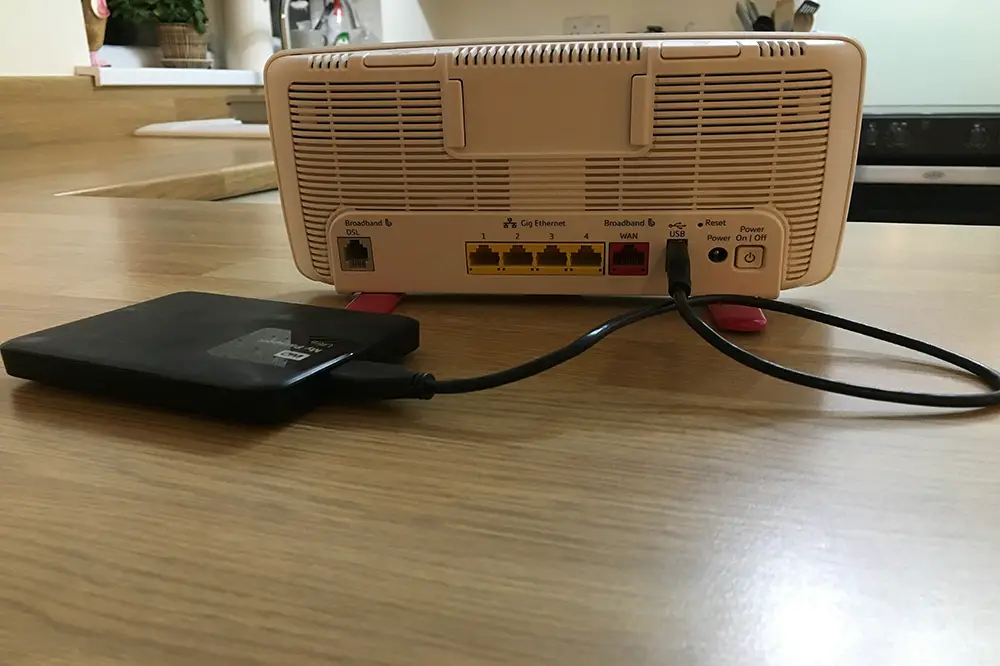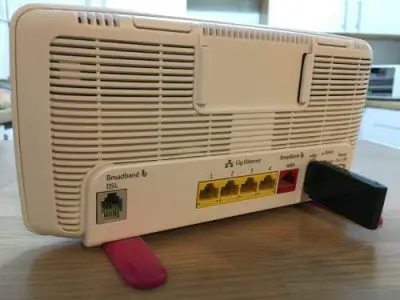Affiliate Disclosure: As an Amazon Associate I earn from qualifying purchases.
Look on the back of your router and you’ll probably see a USB port. A router will typically connect to a modem over Ethernet to provide it with a connection to the Internet, so what is the USB port for?
The USB port on the back of a router allows for different peripherals to be connected. The most common use cases are connecting a printer or external storage device so they are accessible to multiple devices over a wireless connection.
In this article, we’ll look at some of the different ways you can make use of the USB port found on the back of your router rather than letting it go to waste.
1. Connecting an External Storage Device
The best use of the USB port on a router is probably the ability to connect an external storage device.
Simply plug your external storage device into the router and you’ll be able to access it through a PC, laptop, mobile, or really any device that is connected to your network.
If you have data stored externally that you frequently need to share with other members of the household, it can be a pain to have to constantly move the storage device around.
Not only that, but frequently having to move the device around, especially if it is a small USB dongle, greatly increases the likelihood of it being misplaced.
Instead, plug it into the router and it will be accessible to everyone at the same time and is much less likely to get lost.
This does raise a question around why would you bother purchasing a NAS (Network Attached Storage) device when you can simply plug in any old USB hard drive into the router and make it accessible to everyone. Both offer the same functionality, don’t they?
For most home uses, a hard drive connected to the router will suffice over needing to purchase a NAS, however, let’s take a quick look at the advantages of each to help you decide which setup may be best for your needs.
Advantages of USB Router Storage Over NAS
- Affordability: A good quality router with a USB port built-in and the ability to host a storage device and a high capacity USB hard drive will often be cheaper to buy than just the NAS itself.
- Ease of use: Routers with an accompanying storage device are typically easier to configure and manage than a NAS.
- Speed: Many routers will support speeds of up to 1GbPS whereas you would be lucky to see 150 MBPS on a NAS as they are often limited to speeds between USB 2.0 and USB 3.0 speed.
- Compatibility: A NAS may not support all of the devices you have; a router with attached storage is more likely to be compatible with the devices in your home.
Advantages of NAS Over USB Router Storage
- Storage: If you have a very large amount of data or an extensive media library, a NAS is better suited for storing particularly large amounts that extend into the Terabytes.
- Less portable: A NAS is considered not to be a portable device and is much less likely to move around compared to a storage device simply being able to be disconnected from a router.
- Supports multiple use: A NAS is much more accommodating for multiple, simultaneous use. This is what they are designed for, after all.
You may also like: Best NAS for Home Media Streaming: Buyer’s Guide

2. Connecting a Printer
It is possible to connect a printer to the USB port on a router.
This isn’t used as commonly these days due to the more modern printers having the ability to connect to your home network wirelessly, giving more flexibility as to where it can be placed in relation to the router.
That being said, some of the older printers can only be used via a USB connection.
To save everyone in the home having to physically connect their device in order to print, or having to purchase multiple printers, the printer could instead be connected to the router, with it essentially becoming a print server.
This will not only save on the cost of the printer itself as the latest printers that come with more features, such as wireless printing, are typically more expensive, but it just makes printing a much less painful task for everyone in the household.
3. Low Power Charging
It won’t be capable of charging high-end devices that require a large power input, however, the USB port on a router can be used to charge your phone, for example.
This can be useful when you don’t necessarily want to have to plug your charger into a wall outlet, or as a precautionary measure to prevent overcharging the device.
4. Cellular Connections
Connecting a cellular-based USB modem to the router allows you to share a mobile Internet connection with your entire home network.
In my opinion, this isn’t a hugely useful case for the USB port given how reliable broadband Internet services are these days, however, could be handy if you really cannot live without an Internet connection.
Should your broadband service go down for whatever reason, be it a cable fault or a problem with the service itself, the cellular connection provided by the USB dongle can be a great backup solution.
It’s worth noting that not all routers will support this feature, and even those that do will only support certain cellular modems, so be sure to check your router’s manual or with the manufacturer if this is a feature you would like to make use of.

5. Administration and Updates
The USB port on a router can be a useful way to update its firmware, configuration or any other information stored internally.
Updates can be downloaded from the manufacturer’s website, temporarily stored on a USB storage device which is then plugged into the router, and then installed.
Most routers will make sure their latest firmware and updates get installed without the need for you to do anything, but it’s nice to know the USB port is there as a backup.
Can You Plug a USB Hub Into a Router?
Perhaps you wish to take advantage of more than one of the uses I have described above, but there is only a single USB port on your router. So, can you plug a USB hub into the router, turning one USB port into many?
Theoretically, it is possible, however, probably isn’t recommended as the USB port built into a router typically is not the best quality.
Really, it is a nice little bonus and isn’t actually needed for the router to function as it was intended, so manufacturers are unlikely to invest much into a port than many people won’t even use.
I have heard stories of the USB port failing completely when USB hubs were plugged in, so my recommendation would be to stay on the safe side and not plug in a USB hub.
Keep the USB port set aside for whichever use case that we described above that you feel will be most beneficial to you.
Conclusion
The USB port on a router essentially allows you to share a particular device over your network, making it accessible to multiple users or devices at the same time.
The most common, and probably the most useful, uses are for the sharing of an external storage device or an older printer that cannot be connected to the network wirelessly.
Other uses include the ability to charge certain devices that require little power input, an alternative way of being able to install firmware and updates, and the being a backup cellular connection should your primary broadband link go down.
Regardless of what you plan on using the USB port on your router for, I would recommend first checking the manual to ensure it is compatible that that plugging in a non-supported device will not affect the router.
